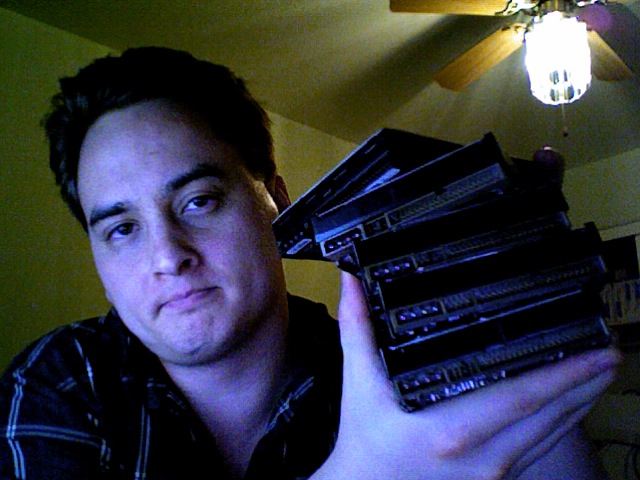 It’s Friday, 10pm, and I’m not a happy camper. This picture is me holding a pile of ordinary hard drives I keep on my home desk. They are cycling backup drives and are not in any way frequently used. Four are Seagate Barracudas–one of which I’ve already had replaced–and the fifth a Maxtor DiamondMax. The oldest of the bunch appears to be from 2002 and all are PATA 200-250GB models.
It’s Friday, 10pm, and I’m not a happy camper. This picture is me holding a pile of ordinary hard drives I keep on my home desk. They are cycling backup drives and are not in any way frequently used. Four are Seagate Barracudas–one of which I’ve already had replaced–and the fifth a Maxtor DiamondMax. The oldest of the bunch appears to be from 2002 and all are PATA 200-250GB models.
I’m unhappy because I picked them up tonight to run a very infrequent backup of all my household data: over a TiB worth while requiring the use of all of them for a complete home backup. Much too my dismay, I won’t be running any backups this weekend.
Failure rate: 100%. (5 out of 5 failures.)
I haven’t been this unhappy with a manufacturer since the last of my IBM DeathStars failed around 2003. Fortunately all the Seagate models are still under warrantee, but such performance is still disheartening and frustrating.
What’s happened to quality drive manufacturing in the 21st century? Some of the ~10MB hard drives in my 486-era machines easily lasted 10+ years, but a single drive these days lasting over 3 seems ever more scarce. Sigh.
4 replies on “Major Seagate/Maxtor Fail”
ouch … FAIL!
i definitely have *lots* of ~ old 10GB drives that still great. meanwhile, lots of my newer, larger drives are often dead when i try booting them up.
interestingly, drives that i keep running 24/7 seem to last awhile whereas, if i don’t boot up a drive for a year or so, there seems to be a greater chance that it won’t boot up.
i wonder if drives don’t like being “forgotten about” and, to spite us, they commit hari kari! :/
I once lost five hard drives in a go. Turns out it was the motherboard (probably). This is frightening, because I am in the process of scanning almost every piece of paper that I own. I have one HD to backup my entire computer, and one to backup a selection of important things. How many backups does a body need? (Too many.)
I am moving to microfiche.
My sympathies!
John
As drive densities have increased, reliability has decreased. I think Scott Moulton mentioned in one of his Defcon talks about how the newer drive heads (that allow higher density on the platters) are fundamentally prone to breaking down faster than the older style heads.
Laurence
The drives lived most of their lives sitting in a pile on my desk collecting dust. No major movements, temperature trauma, or anything I would consider “unusual” treatment.
I think temperature cycling has much to do with MTBF of modern drives, too. I try to avoid massive sudden swings in temperature (such as constantly turning machine power on and off), and keep running drives at a “slightly warm” temperature. This is just ridiculous… and Seagate seems to want me to return each drive in a separate box. F**k that.